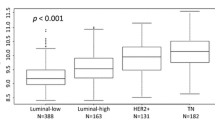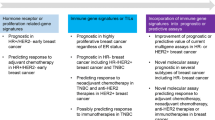Abstract
The involvement of the immune system for the course of breast cancer, as evidenced by varying degrees of lymphocyte infiltration (LI) into the tumor is still poorly understood. The aim of this study was to evaluate the prognostic value of LI in breast cancer samples using microarray-based screening for LI-associated genes. Starting from the observation that most published ER gene signatures are heavily influenced by the LI effect, we developed and applied a novel approach to dissect molecular signatures. Further, a meta-analysis encompassing 1,044 hybridizations showed that LI alone is not sufficient to highlight breast cancer patients with different prognosis. However, for ER positive patients, high LI was associated with shorter survival times, whereas for ER negative patients, high LI is significantly associated with longer survival. Annotation of LI, in addition to ER status, is important for breast cancer patient prognosis and may have implications for the future treatment of breast cancer.


Similar content being viewed by others
References
The R core project team (2007) R: A language and environment for statistical computing. R Foundation for Statistical Computing, Vienna, Austria
Aaltomaa S, Lipponen P, Eskelinen M, Kosma VM, Marin S, Alhava E et al (1992) Lymphocyte infiltrates as a prognostic variable in female breast cancer. Eur J Cancer 28A:859–864. doi:10.1016/0959-8049(92)90134-N
Alexe G, Dalgin GS, Scanfeld D, Tamayo P, Mesirov JP, DeLisi C et al (2007) High expression of lymphocyte-associated genes in node-negative HER2+ breast cancers correlates with lower recurrence rates. Cancer Res 67:10669–10676. doi:10.1158/0008-5472.CAN-07-0539
Aspord C, Pedroza-Gonzalez A, Gallegos M, Tindle S, Burton EC, Su D et al (2007) Breast cancer instructs dendritic cells to prime interleukin 13-secreting CD4+ T cells that facilitate tumor development. J Exp Med 204:1037–1047. doi:10.1084/jem.20061120
Asslaber M, Zatloukal K (2007) Biobanks: transnational, European and global networks. Brief Funct Genomic Proteomic 6:193–201
Balkwill F, Mantovani A (2001) Inflammation and cancer: back to Virchow? Lancet 357:539–545. doi:10.1016/S0140-6736(00)04046-0
Bates GJ, Fox SB, Han C, Leek RD, Garcia JF, Harris AL et al (2006) Quantification of regulatory T cells enables the identification of high-risk breast cancer patients and those at risk of late relapse. J Clin Oncol 24:5373–5380. doi:10.1200/JCO.2006.05.9584
Beissbarth T, Speed TP (2004) GOstat: find statistically overrepresented Gene Ontologies within a group of genes. Bioinformatics 20:1464–1465. doi:10.1093/bioinformatics/bth088
Bertucci F, Finetti P, Cervera N, Charafe-Jauffret E, Mamessier E, Adelaide J et al (2006) Gene expression profiling shows medullary breast cancer is a subgroup of basal breast cancers. Cancer Res 66:4636–4644. doi:10.1158/0008-5472.CAN-06-0031
Bild AH, Yao G, Chang JT, Wang Q, Potti A, Chasse D et al (2006) Oncogenic pathway signatures in human cancers as a guide to targeted therapies. Nature 439:353–357. doi:10.1038/nature04296
Biswas DK, Singh S, Shi Q, Pardee AB, Iglehart JD (2005) Crossroads of estrogen receptor and NF-kappaB signaling. Sci STKE 2005:pe27. doi:10.1126/stke.2882005pe27
Buness A, Huber W, Steiner K, Sultmann H, Poustka A (2005) arrayMagic: two-colour cDNA microarray quality control and preprocessing. Bioinformatics 21:554–556. doi:10.1093/bioinformatics/bti052
Cardoso F, Van’t Veer L, Rutgers E, Loi S, Mook S, Piccart-Gebhart MJ (2008) Clinical application of the 70-gene profile: the MINDACT trial. J Clin Oncol 26:729–735. doi:10.1200/JCO.2007.14.3222
Clamp A, Danson S, Clemons M (2002) Hormonal risk factors for breast cancer: identification, chemoprevention, and other intervention strategies. Lancet Oncol 3:611–619. doi:10.1016/S1470-2045(02)00875-6
Coussens LM, Werb Z (2002) Inflammation and cancer. Nature 420(6917):860–867. doi:10.1038/nature01322
Cox DR (1972) Regression models and life tables. J R Stat Soc [Ser A], 187–220
de Visser KE, Eichten A, Coussens LM (2006) Paradoxical roles of the immune system during cancer development. Nat Rev Cancer 6:24–37. doi:10.1038/nrc1782
DeNardo DG, Coussens LM (2007) Inflammation and breast cancer. Balancing immune response: crosstalk between adaptive and innate immune cells during breast cancer progression. Breast Cancer Res 9:212. doi:10.1186/bcr1746
Diehn M, Sherlock G, Binkley G, Jin H, Matese JC, Hernandez-Boussard T et al (2003) SOURCE: a unified genomic resource of functional annotations, ontologies, and gene expression data. Nucleic Acids Res 31:219–223. doi:10.1093/nar/gkg014
Edgar R, Domrachev M, Lash AE (2002) Gene expression omnibus: NCBI gene expression and hybridization array data repository. Nucleic Acids Res 30:207–210. doi:10.1093/nar/30.1.207
Galon J, Costes A, Sanchez-Cabo F, Kirilovsky A, Mlecnik B, Lagorce-Pages C et al (2006) Type, density, and location of immune cells within human colorectal tumors predict clinical outcome. Science 313:1960–1964. doi:10.1126/science.1129139
Griffith CD, Ellis IO, Bell J, Burns K, Blamey RW (1990) Density of lymphocytic infiltration of primary breast cancer does not affect short-term disease-free interval or survival. J R Coll Surg Edinb 35:289–292
Hayes DF (2005) Prognostic and predictive factors revisited. Breast 14:493–499. doi:10.1016/j.breast.2005.08.023
Hochberg Y, Benjamini Y (1990) More powerful procedures for multiple significance testing. Stat Med 9:811–818. doi:10.1002/sim.4780090710
Kreike B, van Kouwenhove M, Horlings H, Weigelt B, Peterse H, Bartelink H et al (2007) Gene expression profiling and histopathological characterization of triple-negative/basal-like breast carcinomas. Breast Cancer Res 9:R65. doi:10.1186/bcr1771
Lash AE, Tolstoshev CM, Wagner L, Schuler GD, Strausberg RL, Riggins GJ et al (2000) SAGEmap: a public gene expression resource. Genome Res 10:1051–1060. doi:10.1101/gr.10.7.1051
Marques LA, Franco EL, Torloni H, Brentani MM, da Silva-Neto JB, Brentani RR (1990) Independent prognostic value of laminin receptor expression in breast cancer survival. Cancer Res 50:1479–1483
McShane LM, Altman DG, Sauerbrei W, Taube SE, Gion M, Clark GM (2005) Reporting recommendations for tumor marker prognostic studies (REMARK). J Natl Cancer Inst 97:1180–1184
Menard S, Tomasic G, Casalini P, Balsari A, Pilotti S, Cascinelli N et al (1997) Lymphoid infiltration as a prognostic variable for early-onset breast carcinomas. Clin Cancer Res 3:817–819
Miller LD, Smeds J, George J, Vega VB, Vergara L, Ploner A et al (2005) An expression signature for p53 status in human breast cancer predicts mutation status, transcriptional effects, and patient survival. Proc Natl Acad Sci USA 102:13550–13555. doi:10.1073/pnas.0506230102
Nixon AJ, Neuberg D, Hayes DF, Gelman R, Connolly JL, Schnitt S et al (1994) Relationship of patient age to pathologic features of the tumor and prognosis for patients with stage I or II breast cancer. J Clin Oncol 12:888–894
Oldford SA, Robb JD, Codner D, Gadag V, Watson PH, Drover S (2006) Tumor cell expression of HLA-DM associates with a Th1 profile and predicts improved survival in breast carcinoma patients. Int Immunol 18:1591–1602. doi:10.1093/intimm/dxl092
Rilke F, Colnaghi MI, Cascinelli N, Andreola S, Baldini MT, Bufalino R et al (1991) Prognostic significance of HER-2/neu expression in breast cancer and its relationship to other prognostic factors. Int J Cancer 49:44–49. doi:10.1002/ijc.2910490109
Schlingemann J, Thuerigen O, Ittrich C, Toedt G, Kramer H, Hahn M et al (2005) Effective transcriptome amplification for expression profiling on sense-oriented oligonucleotide microarrays. Nucleic Acids Res 33:e29. doi:10.1093/nar/gni029
Smyth GK (2004) Linear models and empirical bayes methods for assessing differential expression in microarray experiments Stat Appl Genet Mol Biol 3:Article3
Sorlie T, Perou CM, Tibshirani R, Aas T, Geisler S, Johnsen H et al (2001) Gene expression patterns of breast carcinomas distinguish tumor subclasses with clinical implications. Proc Natl Acad Sci USA 98:10869–10874. doi:10.1073/pnas.191367098
Sotiriou C, Neo SY, McShane LM, Korn EL, Long PM, Jazaeri A et al (2003) Breast cancer classification and prognosis based on gene expression profiles from a population-based study. Proc Natl Acad Sci USA 100:10393–10398. doi:10.1073/pnas.1732912100
Teschendorff AE, Journee M, Absil PA, Sepulchre R, Caldas C (2007) Elucidating the altered transcriptional programs in breast cancer using independent component analysis. PLOS Comput Biol 3:e161. doi:10.1371/journal.pcbi.0030161
Teschendorff AE, Miremadi A, Pinder SE, Ellis IO, Caldas C (2007) An immune response gene expression module identifies a good prognosis subtype in estrogen receptor negative breast cancer. Genome Biol 8:R157. doi:10.1186/gb-2007-8-8-r157
van‘t Veer LJ, Dai H, van de Vijver MJ, He YD, Hart AA, Mao M et al (2002) Gene expression profiling predicts clinical outcome of breast cancer. Nature 415:530–536. doi:10.1038/415530a
van de Vijver MJ, He YD, van’t Veer LJ, Dai H, Hart AA, Voskuil DW et al (2002) A gene-expression signature as a predictor of survival in breast cancer. N Engl J Med 347:1999–2009. doi:10.1056/NEJMoa021967
West RB, Nuyten DS, Subramanian S, Nielsen TO, Corless CL, Rubin BP et al (2005) Determination of stromal signatures in breast carcinoma. PLoS Biol 3:e187. doi:10.1371/journal.pbio.0030187
Whitford P, Mallon EA, George WD, Campbell AM (1990) Flow cytometric analysis of tumour infiltrating lymphocytes in breast cancer. Br J Cancer 62:971–975
Yao C, Lin Y, Ye CS, Bi J, Zhu YF, Wang SM (2007) Role of interleukin-8 in the progression of estrogen receptor-negative breast cancer. Chin Med J (Engl) 120:1766–1772
Acknowledgements
We thank Sabrina Balaguer-Puig for excellent technical assistance, Andreas Buness for retrieving the external datasets and Dirk Ledwinka for IT support. The study was supported by a grant of the German Federal Ministry for Education and Research (NGFN grant 01GR0418; NGFN grant 01GR0450) and the Austrian Genome Research Program (GEN-AU).
Authors contributions
MS, RK and TB had the initial ideas for the study. AC collected all the data and performed the experiments. TB did the statistical analysis with the help of AC and AB. MA, FP, KZ and HSa collected and reevaluated the patient samples creating the patient samples and annotation for our own dataset. AC, TB, RK, AP and HSü interpreted the results and wrote the manuscript. AC, RK, TB, AP and HSü contributed in discussions. All authors read and approved the final manuscript.
Author information
Authors and Affiliations
Corresponding author
Additional information
Alberto Calabrò and Tim Beissbarth contributed equally to this manuscript.
Electronic supplementary material
Rights and permissions
About this article
Cite this article
Calabrò, A., Beissbarth, T., Kuner, R. et al. Effects of infiltrating lymphocytes and estrogen receptor on gene expression and prognosis in breast cancer. Breast Cancer Res Treat 116, 69–77 (2009). https://doi.org/10.1007/s10549-008-0105-3
Received:
Accepted:
Published:
Issue Date:
DOI: https://doi.org/10.1007/s10549-008-0105-3




